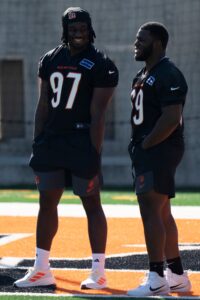This post was originally published on this site
At the offseason’s outset, we projected the edge rusher market — which had not moved too much aside from Nick Bosa‘s contract since T.J. Watt‘s 2021 extension — would take center stage due to the volume of marquee players entering contract years. The fireworks have not disappointed.
The Raiders entered the fray despite having Maxx Crosby contracted for two more seasons, and their early play led the Browns to make the same move — one that took Myles Garrett off the trade block. Garrett’s $40MM-per-year number — which led to Ja’Marr Chase‘s asking price changing, as the title of “highest-paid non-quarterback” gains steam in the NFL — still leads the way at his position, but a glut of edge rushers are still deep in negotiations.
Although both Odafe Oweh and Kwity Paye are heading into their fifth-year option seasons, rumors of negotiations have not emerged involving the Ravens and Colts edge players. Those situations are worth monitoring, but front-burner matters involving All-Pro-caliber rushers — and one curious rookie case — have produced a wave of headlines this offseason. As training camps near, here is where everything stands:
Trey Hendrickson, Bengals
The messiest of these situations has brought a staredown. Although the Bengals have seen a few players (Tee Higgins, Jonah Williams, Germaine Pratt) request trades in recent years, they have not buckled. Hendrickson, though, levied accusations against the team at OTAs and is prepared to sit out regular-season games. This came after executive VP Katie Blackburn‘s comments taking issue with Hendrickson’s stance. Highlighted by the Carson Palmer standoff 14 years ago, the Bengals have not been known to cave. But the team seemingly went from being prepared to move on from Higgins to paying its No. 2 wideout after Joe Burrow‘s crusade. Burrow has stumped for Hendrickson as well.
 Trade rumors here have died down, despite the Bengals giving Hendrickson’s camp permission to shop around. The Bengals rejected multiple offers, and teams viewed the Bengals’ asking price — believed to be at least a first-round pick — as unrealistic since an acquiring team would need to hand out a monster extension as well. Hendrickson made it clear early in the offseason he wanted either a Bengals extension or to be traded to a team that would authorize one; months have passed without either resolution, leading to frustration from a player who has anchored Cincinnati’s pass rush since signing in 2021.
Trade rumors here have died down, despite the Bengals giving Hendrickson’s camp permission to shop around. The Bengals rejected multiple offers, and teams viewed the Bengals’ asking price — believed to be at least a first-round pick — as unrealistic since an acquiring team would need to hand out a monster extension as well. Hendrickson made it clear early in the offseason he wanted either a Bengals extension or to be traded to a team that would authorize one; months have passed without either resolution, leading to frustration from a player who has anchored Cincinnati’s pass rush since signing in 2021.
Hendrickson, 30, went public after no talks commenced in the weeks following the draft and made it known he would extend his holdout into the regular season. The Bengals are likely betting the 2024 sack leader will cave rather than miss game checks, and they have not offered a $35MM-per-year deal — which would surpass Bosa and land in the range Crosby set — to their top defender.
The Bengals also have a long-held precedent of not guaranteeing salary beyond Year 1, joining the Packers and Steelers in that approach. Though, Cincy bent for Chase and Burrow. The team is aiming to give Hendrickson another one-year deal, after extending him (one year, $21MM) in 2023; the ninth-year vet wants a true extension, even if he is not expecting to match Garrett’s Browns terms.
Cincinnati paid Geno Atkins at 30 and Carlos Dunlap at 29 in 2018, authorizing third contracts for both. Hendrickson will be 31 by season’s end, adding urgency to his situation. The team saw its defense regress in 2024, denying an MVP-caliber Burrow season and Chase’s triple-crown showing from producing a playoff berth. Hendrickson has leverage of denying his services to prop up a defense that needs to improve to better the Bengals’ chances at making the playoffs for the first time since 2022. But the sides are not close to an agreement.
 Aidan Hutchinson, Lions
Aidan Hutchinson, Lions
Hendrickson’s price may well change if other rushers land deals that move the bar; Hutchinson is a player to monitor here. The Lions acted early with Penei Sewell, giving the All-Pro right tackle a deal that topped both tackle markets in April 2024. Sewell still resides as the NFL’s highest-paid RT. Hutchinson enters his fourth training camp in position to top the EDGE market, as he is going into an age-25 season. He is also now fully cleared from the broken leg that ended his 2024 season early.
The Lions made it known they were preparing to extend Hutchinson, and fifth-year GM Brad Holmes acknowledged the price could change as other extensions are completed at the position around the league. Hutchinson’s second contract will almost definitely come in north of $40MM per year, as he is nearly five years younger than Garrett. The Lions lacking a proven presence opposite the former No. 2 overall pick also increases his leverage, and the sides are expected to accelerate talks now that a full recovery has taken place.
Detroit striking first here likely would provide a discount. The NFL’s 2023 pressures leader, Hutchinson showing All-Pro-level form again would up his price come 2026. Even with the team having Hutchinson signed through 2026 via the fifth-year option, waiting until the option year could lead to a notably higher price if/once Micah Parsons and T.J. Watt receive their big-ticket extensions before Week 1.
Micah Parsons, Cowboys
Considering how the Cowboys played it with Dak Prescott and CeeDee Lamb, this situation has generated headlines since Parsons became extension-eligible in January 2024. Parsons, 26, is a three-time All-Pro who is the top player on a team. Trade rumors emerged in 2024, but they fizzled fairly early. Even as the Cowboys paid Prescott and Lamb on top-market deals, with the QB breaking new ground by reaching $60MM AAV, Parsons has long been expected to receive an extension. Once again, however, the Cowboys are dragging their feet. This routine has even surprised Parsons, who said the Cowboys waiting once again will lead his price to rise.
 Parsons said during the Cowboys’ 2024 offseason program he was fine waiting until his contract year to sign a new deal, and he expected to become the NFL’s highest-paid defender. Although the Penn State-developed dynamo missed time due to injury in 2024, nothing has really changed regarding that ask. Parsons floated out what appeared to be a $50MM-per-year ask by the spring. It is unlikely the Cowboys will go there, but the fifth-year rusher admitted his price has already risen based on the Crosby and Garrett deals. Parsons’ age and early-career performance work in his favor, and he just saw his top two teammates lead the Cowboys to breaking on their usual term-length aim.
Parsons said during the Cowboys’ 2024 offseason program he was fine waiting until his contract year to sign a new deal, and he expected to become the NFL’s highest-paid defender. Although the Penn State-developed dynamo missed time due to injury in 2024, nothing has really changed regarding that ask. Parsons floated out what appeared to be a $50MM-per-year ask by the spring. It is unlikely the Cowboys will go there, but the fifth-year rusher admitted his price has already risen based on the Crosby and Garrett deals. Parsons’ age and early-career performance work in his favor, and he just saw his top two teammates lead the Cowboys to breaking on their usual term-length aim.
Both Prescott and Lamb secured four-year extensions, being the rare high-profile Cowboys to land deals shorter than five years. Term length is an issue for Dallas with Parsons, but five- and six-year deals are largely avoided now. Only one free agent (Will Fries) agreed to even a five-year deal this year; the cap’s record growth has led players to prefer shorter-term pacts to cash in again sooner. Rumblings of Parsons and Jerry Jones being in step on price emerged, but no reports of a true agreement have come out.
Parsons is still holding out hope for an extension to be done by training camp, even as Cowboys delays have been much discussed, and it represented a good sign he attended the team’s offseason program and participated at points. A hold-in still should be considered likely until a deal is done.
Shemar Stewart, Bengals
The Bengals have managed to pay both Chase and Higgins while still seeing many question their commitment. The team has attempted to distance itself from a frugal reputation; its handling of the Hendrickson and Stewart situations has made that difficult.
 While Hendrickson is amid a classic holdout, Stewart is at odds with his new team over minor contract language. He and Broncos safety Jahdae Barron are the only unsigned first-rounders. Barron signed a waiver that allowed him to participate in Denver’s offseason program; Stewart and the Bengals could not accomplish that. This created a situation in which the Bengals’ top two D-ends were not on the field for offseason work.
While Hendrickson is amid a classic holdout, Stewart is at odds with his new team over minor contract language. He and Broncos safety Jahdae Barron are the only unsigned first-rounders. Barron signed a waiver that allowed him to participate in Denver’s offseason program; Stewart and the Bengals could not accomplish that. This created a situation in which the Bengals’ top two D-ends were not on the field for offseason work.
Language included in the Bengals’ rookie waiver did not sit well with Stewart, who left minicamp early after voicing confusion about the team’s overall goal. The Bengals want to include a clause in Stewart’s contract “that causes a default in the current year to trigger a default in all remaining years.” Stewart also expressed an issue with bonus payments, as his contract would not match the bonus schedule of 2023 and ’24 Cincy first-rounders Myles Murphy and Amarius Mims. Stewart’s agent wants to negotiate this or potentially secure his client a concession rather than the Bengals making an all-or-nothing crusade on this minor matter.
Regardless of how the sides got here, this is not a good place to start — especially given the Hendrickson situation and the team’s poor 2024 defensive showing. Stewart will be attached to a fully guaranteed $18.96MM rookie deal. Offset language has played a role in some of the few holdouts in the rookie-scale era, but the 2011 CBA largely did away with rookie standoffs. The Bengals’ past shows they are unlikely to budge here, putting the onus on Stewart to accept the team’s terms. But this relationship has endured a seemingly unnecessary early hiccup.
T.J. Watt, Steelers
Watt separated from Parsons’ track by skipping minicamp. This also diverges from the All-Pro’s 2021 course, when he staged a hold-in at minicamp and training camp. More material on Watt’s negotiations has come out this time around; the prospect of a training camp holdout — a practice largely curbed by the 2020 CBA — looms. Watt, 30, is aiming to become the NFL’s highest-paid defender. His resume warrants a commitment on this level, but as of this week, no deal is close. Guarantees are an issue this time around.
The Steelers ended Watt’s hold-in days before the 2021 season, reaching a then-market-setting extension (four years, $112MM). More importantly, Pittsburgh gave Watt $80MM fully guaranteed. This broke the team’s non-QB precedent of not providing guaranteed salary beyond Year 1. With Garrett securing $40MM ahead of his age-30 season, Watt (31 in October) naturally wants what his 2017 draft classmate received. Watt can use the threat of not playing — the Steelers are 1-10 in games he has missed — against a team hellbent on changing its recent one-and-done playoff pattern, having signed Aaron Rodgers and traded for D.K. Metcalf, Jalen Ramsey and Jonnu Smith.
 With this situation still unresolved when the team made the trades with the Dolphins, buzz about teams looking into Watt circulated. The team is undeterred. Moving Watt would seemingly be a nonstarter for the Steelers, as it would make little sense to add the cast of veterans they have only to deal away their best player. Even if the Steelers could use a second first-round pick as ammo to trade up for a 2026 QB prospect — after Rodgers’ expected retirement — trading Watt now would severely wound the 2025 team’s chances.
With this situation still unresolved when the team made the trades with the Dolphins, buzz about teams looking into Watt circulated. The team is undeterred. Moving Watt would seemingly be a nonstarter for the Steelers, as it would make little sense to add the cast of veterans they have only to deal away their best player. Even if the Steelers could use a second first-round pick as ammo to trade up for a 2026 QB prospect — after Rodgers’ expected retirement — trading Watt now would severely wound the 2025 team’s chances.
It will be interesting to see if Watt holds out, as the Steelers famously do not negotiate in-season. That separates these talks from the other three veterans’ negotiations. A resolution will happen by Week 1, and it is still expected Pittsburgh will pay up. As it stands, though, the sides are apart on both guarantees and term length. A 2026 franchise tag would become necessary in the event no agreement is reached, but with the team not having negotiated in-season since 1993, a Watt threat to miss regular-season games — no such threat has come out yet — would carry more weight. Both parties want an extension done by camp, but hurdles remain.